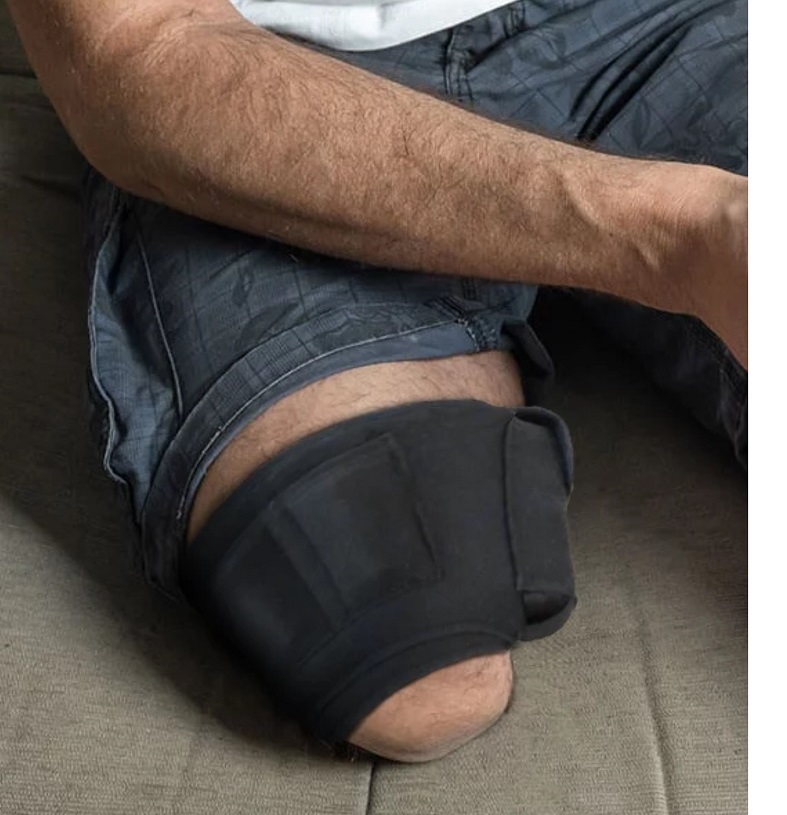
We didn’t know what a massage gun was until our college-age son placed one atop his holiday wish list last year. He’d been introduced to the device by his roommate and weightlifting buddy, who applies it to neck, back, and shoulders to pulse away the soreness after every workout.
The same basic principle underlies TheraV’s wearable ELIX 2.0, a new device that uses vibration therapy to blunt the pain of phantom and residual limbs. Developed over the last four years by Delaware entrepreneur Amira Radovic, the ELIX wraps around the residual limb and purports to thwart PLP by jostling healthy nerve pathways to life, thereby “shutting the gate” on false pain signals. Half a dozen Paralympic gold medalists on the US sled-hockey team swear by the experimental device, and dozens of amputee veterans have endorsed it.
“The first time I used it, I was very skeptical,” says Ralph DeQuebec, a former Marine and current sled hockey defenseman who’s in Beijing awaiting Friday night’s semifinal match. “Then my phantom pain went away and I was thrown off by that. It makes me feel like my brain has to get on rhythm with the device, and then my phantom pain literally just goes away.”
“It’s really helped me out,” adds ex-Army Ranger Josh Hargis. “It’s super user-friendly, very basic technology. I don’t feel like myself whenever I’m taking medication, so something like this that’s non-invasive and simple is huge.”
The scientific evidence behind vibration therapy is inconclusive at best, although there are hopeful glimmers here and there. The practice has been around for many centuries. In the 1890s, neurologists began experimenting with it to alleviate migraines, Parkinson’s disease, and other maladies. More recently, vibration therapy has been clinically studied as a treatment for pain stemming from surgery, cancer, arthritis, and repetitive use. In the 1970s, British doctors started treating residual limb pain and phantom pain with hand-held vibrators; they described this approach as “extremely useful” in the Annals of the Royal College of Surgeons. And a 1985 paper by Swedish researcher Thomas Lundeberg concluded that “vibratory stimulation may be a valuable symptomatic treatment measure in patients suffering pain from a phantom limb.” Three-fourths of Lundeberg’s research subjects reported that vibration therapy brought relief from PLP.
It remains an active research frontier; the ClinicalTrials.gov database lists dozens of current or recent studies related to vibration therapy. But, as with so many other PLP management strategies, there’s still no hard evidence that it works. Many people seem to have benefited from vibration therapy, but statistically speaking it’s no more effective than a placebo.
TheraV’s own data are certainly promising. According to the company’s white paper, early adopters of the Elix 2.0 saw an average pain decrease of 3 points (on a 0 to 10 scale) with consistent use. “It works on the same basis as TENS [transcutaneous electrical nerve stimulation],” says Radovic, referring to another much-studied pain-control method. “But it uses mechanical stimulation instead of electrical stimulation.” There are even parallels between vibration therapy and peripheral nerve stimulation, a more sophisticated (and invasive) means toward a similar end: activating healthy nerve signals while drowning out dysfunctional, PLP-causing connections.
An alumnus of MIT’s VentureWell Entrepreneur team, Radovic is trying to take a scientific approach with the Elix 2.0. The device is Bluetooth-enabled and comes with a smartphone app that continuously records data on the frequency, duration, and intensity of use. The app includes a simple, easy-to-use pain log that Radovic hopes will yield more consistent data than the pain journals typically used to evaluate tools of this type. “Our overall goal is to have a better understanding of phantom pain,” she says. “The point is to improve amputee care.”
The first batch of ELIX 2.0 devices were delivered last month, fulfilling a raft of pre-orders. Supply-chain issues have complicated the timeline for the next wave of units. If you’re interested in joining the waitlist, enter your info at TheraV’s website. To learn more about ELIX 2.0, contact Radovic at info@weartherav.com.
And if you’re among the proud, the few, who have tried the ELIX 2.0, send us a note and let us know about your experience.